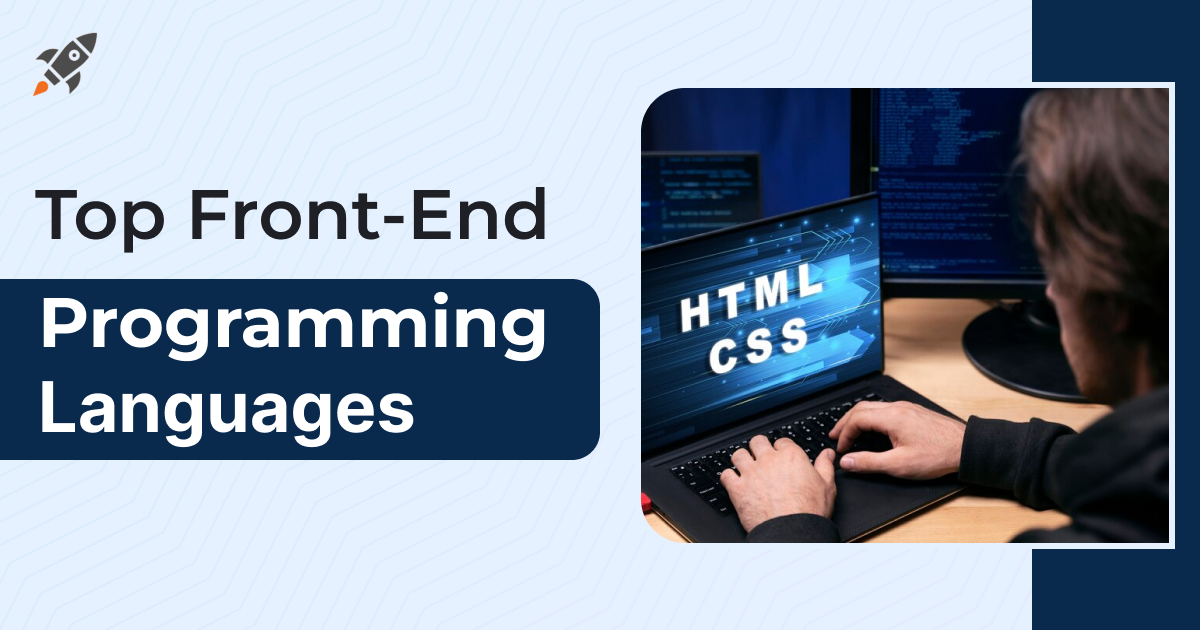The software development landscape is incomplete without the front-end development languages of today. Like runtime environments and development frameworks, programming languages are also evolving. Like backend languages, front-end programming languages are also developing greatly. The top front-end languages and their trends are discussed in this article.
What is front-end development?
The front end of a software application or website is the client-facing, user-interactive interface. This is where the user first interacts with a digital product, forming initial impressions before delving deeper into its backend performance. Backend languages, utilized by software developers, lay the foundation for the functionality of an application.
However, with the increased importance of user interaction and user experience, front-end languages and development also hold a lot of importance. Front-end languages are continually evolving, integrating innovative technology to unlock the fullest potential in UX and UI design. From Digitalogy, you can hire experts like React JS Experts and much more as per your needs. These professionals are adept at leveraging front-end languages to develop cutting-edge apps and digital products.
Developers and development companies are using front-end languages and tools to create the best type of apps and new digital products, ensuring users are greeted with visually appealing and highly functional interfaces. This fusion of front-end innovation and backend solidity is essential in delivering a cohesive and engaging user experience across digital platforms.
What are the trends of front-end in 2024?
Many new trends in the front-end development landscape are developing today. The incoming of different technologies and capabilities into the front-end development sector has created superior languages and tools for front-end development. The predominant trends of front-end development that developers are predicting in 2024 are as follows-
Integration of AI
AI programs like ChatGPT are emerging as the most advanced algorithms in the programming landscape. AI has turned out to be a friend to humans till now, and programmers are trying to create wide-scale far, far-reaching applications of AI.
Therefore, it is not surprising that developers are looking towards the applications of AI in front-end development. AI simplifies the crucial steps of app development, and front-end development is much faster.
If programming languages become AI and NLP enabled, it will be much simpler to code for the front end of websites and applications. Ai-enabled algorithms have self-learning capabilities that automate the building and coding of front-end layouts. The design and integration of front-end elements are easy and unique with the help of AI.
JAMstack
Apart from technical integration and trends of AI, the front-end development sector is also looking at the architecture of front-end frameworks with the help of new front-end development frameworks such as JAMstack.
The JAMstack framework is a web infrastructure development framework that combines client-side JavaScript and reusable APIs to create robust front-end layouts. Another development in the architecture and infrastructure field of the front end is the rise of micro front-end codes that are individually developed and later integrated into the larger framework for more symmetry and accuracy.
What are the best Front-End Languages of 2024?
To bring in the most important and predominant trends of 2024, the front-end languages of 2024 have to be new-age and robust. The top 10 front-end languages of 2024 are discussed below.
1. HTML5
HTML has existed for ages and is known as Hypertext Markup Language. It is one of the oldest and most popular front-end languages of today. HTML has developed and evolved to retain its importance over the past few years.
HTML5 is a good front-end language for integrating multi-media elements and creating an interactive webpage. HTML 5 can also be used to add gamification elements to the website or app so that the audience is better engaged.
The newer versions of HTML are used widely by front-end programmers even today. The programming language is very easy to use and creates lightweight websites and gaming interfaces. With the rise of games in the internet landscape, HTML 5 is gaining more relevance.
2. CSS
Cascading Style Sheet (CSS) is a styling and presentation language usually used in line with HTML code and elements to create multi-media pages and apps. CSS is a classic front-end language that brings in themes, colors, and fonts for web development. It has an easy syntax and works well with other front-end languages. These features and their versatility make it very relevant among the coding languages of 2024.
3. JavaScript
JavaScript is another classic, versatile language that has been used to create websites and apps for use. More than 90 percent of the present websites on the internet use Javascript for development and updates.
Many development frameworks depend on the JavaScript framework for development. JavaScript has an easy syntax and support from many open-source libraries, which makes it very popular among front-end developers.
4. React
React JS, like JavaScript, is a very important and widely used front-end programming language. React JS is popular because it is an open-source library that can be used with Javascript and already-developed code. Because it is free to use, it is used by professional developers around the world.
The language has been used to create new UI components for the different areas of web and application development. Many web applications and tech platforms like Meta, Instagram, and Yahoo Mail have been created using the React JS platform.
5. Angular
Angular is much like React, but it uses Typescript instead of JavaScript as its base. The web application frameworks work well for front-end development. The language framework was used to develop new applications of Autodesk and Microsoft.
Angular is very efficient and versatile as it distributes the load between the back end and front end for better HTML programming. There are built-in coding features of Angular that make front-end development very easy for programmers.
6. Vue.js
Vue or Vue.js is an open-source language framework that can be used for free under its model view structure. The language is one of the new front-end languages released in 2014. The language framework is suitable for user interface development. The framework specializes in the development of single-page websites.
As the popularity of single-page, easy-to-view, and lightweight websites that also double up as PWA websites go up, the popularity of Vue also goes up. Its adaptable architecture is a great feature that allows the programmer to use the framework very flexibly.
7. ELM
ELM is a domain-specific front-end programming language that specializes in the development of Graphic user interfaces. The language is used for creating simple web applications that run in browser mode. The simplicity, usability, and performance of this highly specific and new language make it a very good front-end development programming language. The language is used to create an interactive web application.
8. JQuery
JQuery is a JavaScript-supported software that works for tree traversal and event handling. The software operates under an MIT license. The software is integrated with the code for 77 percent of the most popular websites today. JQuery is increasingly becoming popular for front-end developers to make user interaction very intuitive.
9. Swift
Swift is a new age general, purpose front-end development language launched by Apple. The 2014 language has undergone many updates and is used to develop iOS applications and Android applications. With the demand for iOS developers increasing, programmers are learning Swift to a greater extent. Swift is one step ahead of its predecessor, the Objective C language.
10. SASS
SASS is the successor of CSS and works well with the code and interface of CSS. If you are looking into new-age front-end languages that are the advanced versions of CSS, SASS is a good option. It is a scripting language that can be compiled to create higher styling elements for web applications and websites. It is an upgrade on CSS extension languages for front-end developers.
Conclusion
Bringing together visual, sound, animation, and textual elements to create one interactive interface and then linking it with the backend skeleton of a website or app is an extensive process. With the innovations of front-end technologies and the rise of new front-end languages, the world will usher in new user interfaces and experiences for its websites and applications. As professional developers, it is important to continue upskilling in the sector of front-end capabilities for an upward career graph.







